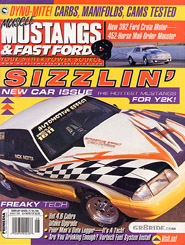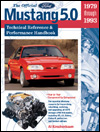|
The Official Ford Mustang 5.0
Price: $69.95
|

Muscle Mustangs & Fast Fords - August 2000
The Fox-bodied Mustang came into being during a time when the automotive world was on a rebound - coming off the overly emissions-conscious '70's when performance was somewhat of a dirty word - into the '80's when small imports offered snappy handling, light weight and turbocharging was the wave of the future. From 1979 to 1993, the Mustang became a favorite on the street and the drag strip based on its relative affordability and the outstanding performance from its venerable 5-liter powerplant. Today, the Fox-chassis has given way to Fox-4, but the love of Blue Oval fans for the earlier cars is stronger than ever. Few publications have throroughly told the story of this version of Ford's record-setting performer until now.
Al Kirschenbaum's 440 page to me is an exhaustive history compiled by an automotive journalist who was covering Detroit's offerings long before the Fox came out and who was there throughout the platforms's 15-year production life. Complete with its very own Ford part number, The Official Ford Mustang 5.0 Technical Refeence & Performance Handbook is divided into two sections, Year by Year Overviews and Component Systems. A 22-page introduction provides production highlights, tells the story of the platform's development and offers VIN information, body and engine codes and identification and an explanation of Ford's parts numbering system.
Obviously, the 17 chapters in Part One - Year by Year Overviews - give all the historical production statistics on each model year. Kirschenbaum, a contributing editor to MM&FF for years, uses a direct writing style to present all the factual information one could imagine in a very ordered manner. Everything from body treatments, interior, packages and models to tables for production volumes, powertrains and specifications are given in-depth coverage. There are even specific chapters dedicated to the '93 Cobra, Cobra-R and Special Service Vehicles. Throughout, the narrative gives tons of informaiton on unique features, model year changes and the intent behind them.
Part Two offers the most detailed analysis yet in print of the major and minor component systems that comprised the Fox Mustangs. It breaks down into 15 chapters for the individual components, starting with the namesake Fox unit-body chassis. You've got it all - structural and finished paint difficulties encountered during production, exterior features, sunroof, T-tops, lighting, body add-ons and there's even a table listing the applications and styles for OE spoilers. Of course, the heart of the matter is Chapter 19 - Engine. Starting off with the development of the small-block V-8 in 1960, this chapter is filled with the minutiae (every component, from cranks to heads) of every aspect of the 5-liter's lifeline. Specification tables, history and highlights, engine nomenclature and even the introduction of the modular motors is included. This will pretty much give the stock bench racing set every bit of verbal ammunition they'll ever need.
The remaining chapters in Part Two continue in the book's thorough manner, delving into engine subsystems, (ignition, EEC, exhaust, etc.) suspension, transmission, wheels and tires and everything else that made up the Fox Mustang. When Kirschenbaum gets around to hot rodding the Mustang and aftermarket offerings, rather than provide dated how-to installation material, he instead gives generic overviews of the different styles of performance altering systems that are available and discuss the pros and cons of each. I personally find this refreshing, because it's done in a manner that doesn't try to shove any one particular product down the reader's throat. Instead, the author gives enough information that it should prove helpful if and when the time comes for one to make a decision on how they want to increase performance.
I could go on for a few more pages about this book, like for instance how it's the first time anywhere where I've found charts listing the optimal shift points for the T-5 and SROD gearboxes, including all the different rear-end gear ratios. Stuff like that is as good as gold and there's plenty more where it came from. To call this an exhaustive undertaking is an understatement. Al Kirschenbaum's Official Ford Mustang 5.0 Technical Refeence & Performance Handbook 1979-1993 now ranks as the definitive Fox Mustang fact source and more. It gets an off-the-scale 1-plus G rating on the stick-to-my-shelf meter.
-MM&FF Staff
![[B] Bentley Publishers](http://assets1.bentleypublishers.com/images/bentley-logos/bp-banner-234x60-bookblue.jpg)
